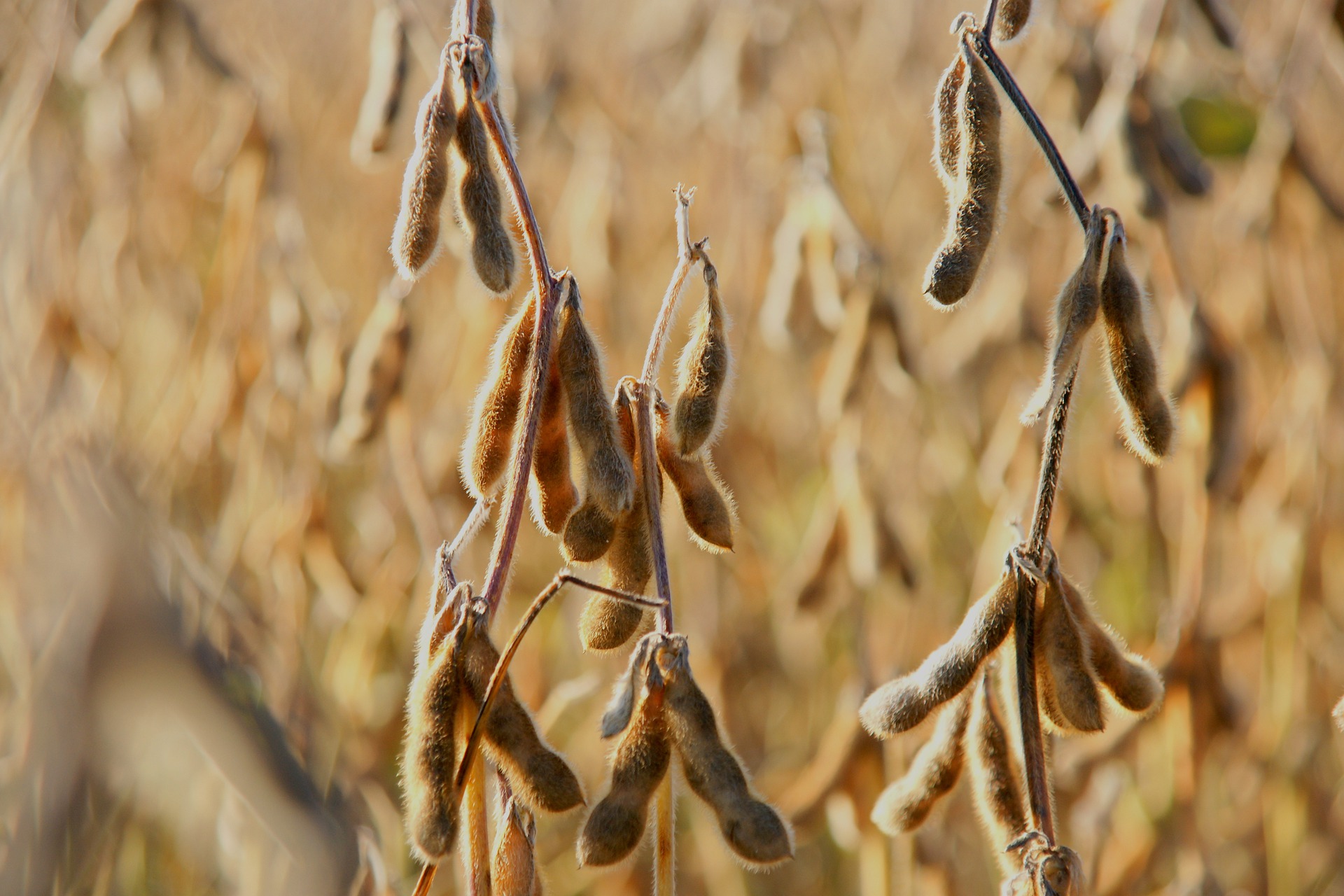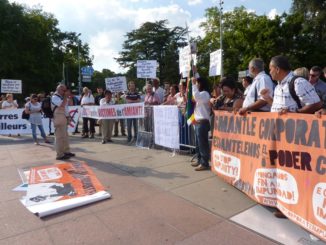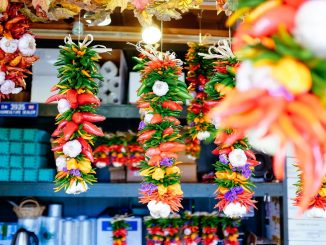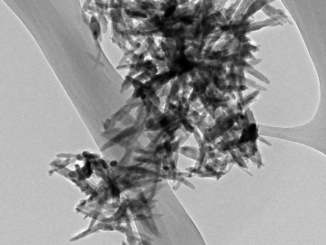
The FAO expects former Soviet countries like Ukraine to play an important role in feeding the world the coming decades. But questions remain about who will benefit from the oncoming agricultural gold rush.
Sumy is a small city located in the north-eastern part of Ukraine. An impenetrable mist seems to hold the town hostage on a cold winter day in December. I’m in Sumy because the Kiev-branch of Donau Soja Organisation has organized a seminar for farmers at the regional agricultural university. Local food is served while about forty farming professionals gather in a small classroom on the fourth floor. A German-speaking salesman hands out leaflets about plowing technology that would enable them to decrease the amounts of chemicals on the field or avoid having to use expensive biotechnology altogether.
The farmers want to stay competitive while keeping their practices sustainable in a highly competitive environment, Volodymyr Onatskyi says. Soviet visuals depict classic images of noble workers on the walls. Outside three tanks and a rundown jetfighter add to the dab greyness of the city.
Ukraine has seen rapid land concentration since independence in 1991. But according to a 2013 report by the UN Food and Agricultural Organization (FAO) global food supply and demand projections indicate an increasing role for the former Soviet countries Kazakhstan, Russia and Ukraine in feeding the world – mainly because of their fertile soils, low land prices and proximity to important markets in Europe, China and the Middle East. According to FAO agricultural outputs could even grow by more than 30 percent.
Onatskyi grew up on a farm outside Sumy. Since 2009 he runs a small company selling seeds and natural fertilizers to farmers around town. Over the years an increasing amount of land has ended up in the hands of a few big agricultural holdings, he says. Evermore soya is being grown in the area every year. “Half of all agricultural land around Sumy is now owned by large landowners,” Onatskyi explains. “They run big monocultures whereon soybeans gets planted again year after year. They pay no mind to healthy crop rotation. Agricultural practices like these are impossible to sustain if we want to be able to pass the land on to our children.”
European fringes
The organizer of the seminar in Sumy, Donau Soja Organisation, is headquartered in Vienna. Since start of operations in 2012 the international non-profit association has rapidly expanded into most countries around the course of the Danube river and now runs offices in Austria, Serbia, Moldova, Romania, Poland and Ukraine. The goal of the organization is to bring back protein production onto European soils. That could have not only major environmental advantages, but would also create the much-needed economic opportunities for farmers on the impoverished European fringes – like Ukraine.
Besides being a global powerhouse in sunflower oil and wheat – Ukraine is also the biggest soybean producer in Europe. According to a sector analysis done by Donau Soja Organisation, exports Ukrainian soybeans have increased tenfold between 2006 and 2016. After seemingly unbeatable giants Brazil (56% of the global market) and the United States (29%), Canada, Paraguay (both 3,7%) and Argentina (2,3%), Ukraine (1,4%) now ranks as the sixth biggest exporter of soya worldwide.
Backlash
The European Union (EU) is the biggest buyer of Ukrainian for soya. But a big chunk of the soya the EU imports to feed its cattle, still comes from South-America. According to calculations by the Dutch Rabobank Europe imports up to 30 million tons of South-American soya each year – with devastating effects on rain-forests in Brazil. Because of that, there is increasing unease about Brazilian agricultural imports.
After populist and export-savvy president Jair Bolsonaro took power in Brazil, record-losses of Amazonan forest coverage have been recorded. Only during May 2019 a total of 739 square kilometers of Brazilian jungle got slashed to make way for largescale soybean and sugar plantations. Since then indigenous land rights are under pressure and activists face more violence.
Ukraine might prove a viable alternative to provide for European soya-hunger, John Shmorhun of AgroGeneration admits: “Right now the Ukrainian agricultural industry has to compete with French farmers heavily subsidized by the EU or with large plantations in Brazil. However, the cost of labor is still quite low in Ukraine and land is relatively cheap. The soil here is unbelievably fertile and historically this country has always been a bread basket for the Soviet Union. If we can produce on a scale large enough, Ukraine could develop into a real exporting powerhouse.”
Small player
Shmorhun is an American by birth, but moved to the Ukrainian capital of Kiev years ago. He is the CEO of AgroGeneration since 2013. The company is publicly traded and operates about 60.000 hectares of farmland all over Ukraine. AgroGeneration mainly focuses on corn and sunflower oil – but also has soya in its portfolio. But in comparison to the biggest agricultural holdings in Ukraine AgroGeneration is still a relatively small player, Shmorhun laughs. Fully integrated conglomerates like Kernel (leasing and operating more than 500.000 hectares) or Myronivsky Hliboproduct (MHP – 370,000 hectares of land, mostly corn and sunflower, used in part to produce 593.0000 tonnes of chicken meat, consumed in Ukraine or exported to upwards of 80 countries) operate through a complex network of subsidiaries to circumvent the Ukrainian moratorium on land sales and are often registered in what are considered to be tax havens outside the country.
Other major agricultural players have flocked towards Ukraine as well. For the seed giant Bayer-Monsanto, Ukraine represents more than 20 percent of the total European market and grain trader Cargill started loading ships this fall from a brand new cargo in the port of Odessa at the Ukrainian Black Sea coast. Shmorhun: “If the new governments succeeds in creating a business friendly atmosphere there are plenty of opportunities for agricultural development in Ukraine. It’s especially important to lift the moratorium on selling land. That would make it easier to use land as a collateral to get loans and create an incredibly lucrative investment opportunity and a real export bonanza for Ukraine.”
Profit
But who would actually profit from that export bonanza remains controversial. More foreign investment could increase land acquisition which would lead to even quicker land concentration into the hands of big agricultural holdings, Mykhailo Amosov of the Kiev-based research institute EcoAction fears: “Ukraine has a lot of export potential. If the biggest agri-producers keep their focus on the export of raw materials that’ll only grow. This runs parallel to land concentration problems. Land concentration helps to get a bigger income from export and earn back your investment so that’d again mean more demand for land. Sustainable production of soy or any other crop should be regulated and monitored by the Ukrainian government.”
Government control is however lacking in Ukraine. Import and cultivation of genetically modified (gmo) soya is prohibited in Ukraine. According to field tests by the Romanian ngo Agent Green in six key production regions, 48 percent of all samples tested positive for gmo-contamination.
At the university campus in Sumy Volodymyr Onatskyi sighs and looks out the window. The harvest has just ended. In the distance a lonely blue truck drives on over the potholed streets of rural Ukraine. “Around Sumy around sixty percent of all soybeans are genetically modified,” Onatskyi says. “At the same time it’s prohibited by law to even grow gmo-soya. The government simply doesn’t even care about what big companies do. While we should be worrying about finding more sustainable forms of agriculture.”
More on Ukraine
Quietness & Adaptability – Ukrainian Peasants’ Responses to Land Grabbing & Agribusiness Expansion





